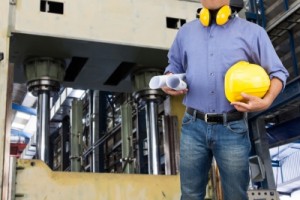“Houston we have a problem” must have been the mindset of the VP of finance when he requested a “can we meet right now” meeting with our CEO Scott Ringlein. A major component in the company’s production line had broken down and what was formerly an automated process was now being done by hand.
To replace the broken equipment was going to cost upwards of $700,000, and the company had already allocated significant funds to an upgrade of their outdated facility lighting. The lighting was original equipment that was common in the era when the building was constructed in the 1970’s. The outdated lights were wasting a tremendous amount of energy in the form of unwanted heat and some were no longer in production making replacement bulbs difficult to buy. Since new energy efficient lighting was long overdue and money was already committed to the lighting project, funds for replacing the expensive broken equipment would not be available. What made matters worse was the broken equipment was costing the company money due to the increased cost of manual production.
“It was costing more to process the individual parts than what was originally quoted because the quote assumed a fully automated system!” Scott Ringlein, EAGM CEO
The contractor responsible for the lighting upgrade project understood the situation and asked the Vice President if he was aware of Property Assessed Clean Energy (PACE). He noted that PACE would allow the company to finance the rest of the lighting project, as well as recover the money already spent on the lighting retrofit, freeing up much needed capital for the new equipment. The VP wanted to learn more and the contractor suggested a call to our CEO due to his extensive experience with PACE project development in Michigan.
The call was made and a meeting was set up on very short notice. CEO Scott Ringlein explained PACE to a gathering of the company leadership who previously knew nothing about PACE and wanted to learn all they could. They were in dire need of a solution and it appeared that PACE could be that solution.
Upon hearing that PACE funds a broad array of energy efficiency options, the VP noted the new equipment used compressed air to operate and was quoted as being 30% more efficient than their present machine. The VP wanted to know if the cost of the equipment could also qualify for PACE financing. Ringlein assured the VP that since PACE can be used to fund improvements in process efficiency as well as energy efficiency, the machine would qualify! That cinched the deal and the VP wanted to know what the next step was and how fast it could take place.
The “next step” was the facility walk through by the EAGM energy team which took place last week. Due to the age of the various buildings there were many areas where PACE could be used for a comprehensive upgrade including: HVAC, building envelope, high speed doors, light harvesting and renewable energy. A preliminary presentation was made to the company leadership and a PACE proposal is currently being developed.
“Petros PACE Finance, one of Michigan’s leading lenders, is ready and able to provide $1 billion in on-demand financing for PACE projects in the coming years.” Kyle Peczynski, Lean and Green Michigan
Even though significant funds are available for PACE projects, many company executives aren’t even aware of this problem solving option. Being a relatively new program the learning curve has yet to be overcome.
To help overcome the learning curve a PACE Project Calculator has been created by The Energy Alliance Group of Michigan. By simply entering nine property variables the calculator will provide an instant PACE Project Viability Score that can help determine if PACE may be an option for an intended project. The calculator is a great first step for any project that will need financing for energy efficiency upgrades.
It is always interesting to watch the pieces of the puzzle that come together to create successful energy efficiency projects. No two projects are ever the same. In this case the PACE piece of the puzzle would have never even been considered if not for the knowledgeable contractor who was able to provide a solution that went way beyond the service he was already providing.
The manufacturing company is eager to return to normal production and it appears PACE will be the mechanism that makes that happen. This will be an interesting project to report on as it evolves.


Leave a Reply